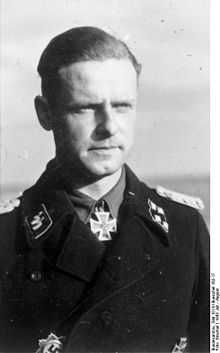Martin Groß
| Martin Groß | |
|---|---|
 | |
| Born |
15 April 1911 Frankfurt, Germany |
| Died |
1 March 1984 (aged 72) Germany |
| Allegiance |
|
| Service/branch |
|
| Years of service | 1933–45 |
| Rank | Obersturmbannführer |
| Unit |
1st SS Division Leibstandarte SS Adolf Hitler 12th SS Panzer Division Hitlerjugend SS Panzer Brigade Gross |
| Commands held |
II./1st SS Panzer Regiment LSSAH 12th SS Panzer Regiment.12th SS Panzer Division Hitlerjugend SS Panzer Brigade Gross |
| Battles/wars | World War II |
| Awards |
Knight's Cross of the Iron Cross Iron Cross 1st Class Iron Cross 2nd Class German Cross in Gold Infantry Assault Clasp in Bronze Wound Badge in Gold Tank Combat Badge |
Martin Groß (15 April 1911 – 1 March 1984) was an Obersturmbannführer (Lieutenant Colonel), in the Waffen-SS (SS number 6684) during World War II.
Background
He was born in Frankfurt on 15 April 1911. Information about his early life is sparse.
Career in the Waffen-SS
He was a Battalion commander in the 1st SS Division Leibstandarte SS Adolf Hitler where he commanded the II/Battalion of the SS Panzer Regiment 1. It was when he was in command of this battalion, during the Battle of Kharkov in 1943,[1] when he was awarded the Knight's Cross in July 1943 for a three-hour engagement when his battalion destroyed 90 Soviet tanks.[2]
In August 1944, Groß was given command of a new Panzer Brigade, known as SS Panzer Brigade Gross. The brigade was formed from elements of the SS Panzer Troop Training and Replacement Regiment at Dundaga (German: Dondagen), Latvia, along with SS Panzer Troop Training Regiment "Seelager". By 16 August, the brigade had attained a personnel strength of 2,500 and was attached to a new and temporary Divisional Command: Panzer Division Strachwitz.
The brigade first went into action against the Soviet 51st Army units in and around the town of Tukums on 20 August. In September, Brigade Gross was detached from Panzer Division Strachwitz and dispatched to the Tartu area to counter another Soviet offensive. The brigade fought in the Baltic area from September to October 1944.
In November the unit was withdrawn from the Baltic and sent to the Waffen SS Troop Training Area Sennelager near Danzig, East Prussia (present-day Gdańsk, Poland). From there it was sent to another training area in Westphalia. There the brigade was broken up and its men sent to the 1st SS Panzer Division Leibstandarte SS Adolf Hitler, 2nd SS Panzer Division Das Reich, 9th SS Panzer Division Hohenstaufen and the 12th SS-Panzer Division Hitlerjugend, which were a part of the 6th Panzer Army. The disbanding of Brigade Gross was disguised as the forming of a new panzer regiment: SS-Panzer-Regiment 26 Reichsmarschall.[3][4]
In March 1945 Groß was transferred to the 12th SS Panzer Division Hitlerjugend and was the last commander of the SS Panzer Regiment 12.[5]
Decorations
- Iron Cross II: 1 October 1939
- Iron Cross I: 20 July 1940
- Inf. Assault Badge: October 1940
- German Cross in Gold: 28 March 1943
- Knight's Cross: 22 July 1943
- Wound Badge in Gold:
- Tank Combat Badge in Silver:
Promotions
- SS-Untersturmführer: 10 March 1935
- SS-Obersturmführer: 9 November 1936
- SS-Hauptsturmführer: 30 January 1940
- SS-Sturmbannführer: 30 January 1943
- SS-Obersturmbannführer: 9 November 1944
SS Panzer Brigade Gross Order of Battle (8 Aug. 1944–Nov. 1944)[6]
- Brigade Headquarters
- 1st SS Infantry Battalion
- 4x Companies
- 2nd SS Infantry Battalion
- 4x Companies
- SS Panzer Battalion "Gross"
- 3x Companies
- Schwere Panzer Company
- 1st SS Sturmgeschütz Battalion
- Artillery Batteries x2
- SS Panzer Reconnaissance Battalion "Gross"
- Motor Cycle Company
- Panzer-Späh Company
- RAD/Kettenrad Company
- Flak Company
- 4x Platoons
- Pionier Company
- Military Police Troop
- Supply Company
- Workshop Company
References
- ↑ Panzer Aces By Franz Kurowski p.309
- ↑ Panzer Aces By Franz Kurowski p.311
- ↑ "SS-Panzer-Brigade "Gross"".
- ↑ Antonio J. Munoz - Forgotten Legions: Obscure Combat Formations of the Waffen-SS
- ↑ The 12th SS Volume Two By Hubert Meyer p.381
- ↑ Antonio J. Munoz - Forgotten Legions: Obscure Combat Formations of the Waffen-SS
| |||||||||||||||||||||||||||||||||||||||||||||||||
